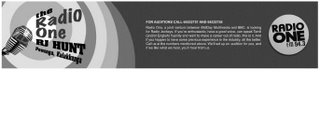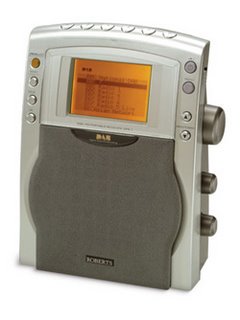RADIO HAVANA CUBA
DXERS UNLIMITED
DXERS UNLIMITED'S WEEKEND EDITION NOV 4 -5 2006
BY ARNIE CORO
RADIO AMATEUR CO2KK
Hi amigos radio aficionados ! You are now listening to the weekend
edition of Dxers Unlimited, your favorite radio hobby program, covering
each and every aspect of our wonderful way of using our spare time.
YES,
there are more than 80 different ways that you can enjoy this hobby...
from listening to the AM broadcast band with a very inexpensive little
radio trying to pick up distant stations late in the evening, to taking
part in one of the big worldwide amateur radio contests... From
soldering the last electronic component to a printed circuit board that
will let you listen to the aircraft VHF band when connected to your
short wave radio, to installing a home brew antenna that will extend
the
range of your ham radio station... Si amigos, there are many different
and always challenging ways of enjoying the radio hobby... and that's
exactly what I want you all to think about every time that you have a
chance to start a new radio project... For example, listener Anil from
Mumbai , India, writes via e-mail to tell me that he has picked up
Radio
Havana Cuba's short wave broadcasts on 15230 kilo Hertz, something
surprising if you consider that 15230 kilo Hertz at the time that he
heard that transmitter was using our 160 degrees azimuth curtain array
of dipoles antenna... It seems like an odd radiation lobe of the big
curtain was making its way to India, across the Pacific Ocean, or as
one
of our engineers said , one never knows how a big antenna radiation
pattern may generate small lobes, that are the ones that produce such
unusual reception in far away places, even when the main lobe of the
antenna is pointing to a completely different azimuth..
More about reception reports received here , and what to expect during
the frequency management period BO6 that has just started a few days
ago.
Stay tuned for more radio hobby related items, coming to from Havana...
I am Arnie Coro..
.....
This is Radio Havana Cuba, the name of the show is Dxers Unlimited, and
yes, we do QSL , we do verify reception reports, and we do it the way
it
should be done... absolutely free of charge ... since the very first
day
that we tested a one Kilowatt Gates shortwave transmitter connected to
a
half wave dipole that was strung between two wooden poles provided by
the local electricity utility's storage yard near our Bauta
transmitting
station, we asked for signal reports, and as soon as they started to
come in, we began to answer them... and I remember from those days,
that
we went to the post office to buy stamps , and asked the girl at the
counter for the most beautiful Cuban stamps , so that when we sent out
the first Radio Havana Cuba QSL letters, listeners will also receive
Cuban stamps too...
You can send your signal reports and comments about this and other
Radio
Havana Cuba's programs via e-mail to arnie@rhc.cu, again arnie@rhc.cu,
and if you are not yet in cyberspace, send an AIR MAIL postcard to
Arnie
Coro, Radio Havana Cuba, Havana, Cuba...
Now more about B-06, and for those of you not familiar with that term,
now the international broadcast stations that use the so called HF or
more properly decametric bands, divide the year into two periods A and
B, each lasting six months. But the broadcast schedule periods don't
start on the first day of January, and end on the 31st of December...
The start up dates for the so called winter period, also known as the B
period, start at the end of October and lasts until some time in
March... This period that started a few days ago is known to broadcast
station frequency management engineers as B 06... And when B 06 ends in
March of 2007, then the A 07 period will start , covering all of the
summer season and a few weeks more until late October of 2007 when the
B
07 period will begin...
Selecting the best frequencies for broadcasting to the different target
areas of international short wave stations is a very complicated
process, that requires a lot of know how about antenna systems and
radio
wave propagation.
Managing the frequencies of a short wave station is quite a task, and
engineers make use of the most up to date computer programs, solar
activity forecasts and of course, that we do rely a lot on listener's
feedback, because short wave radio propagation is far from been an
exact
science...
In a few days time, our station Radio Havana Cuba will implement the
B-06 schedule, that this year is coming a bit late for us, due to the
need to finish working on several new antennas....
For our English language program listeners in North America, there are
a
few changes that are required due to the much lower solar activity
expected during the next several months... For example, our long time
frequency that has served so well listeners in the Central time zone of
North America, 9820 kilo Hertz , can not be used effectively during the
B-06 period, so we are changing it to a lower frequency band... YES
amigos, we are moving away from 9820 kilo Hertz from 23 hours UTC to 05
hours UTC , and will start using instead 6180 kilo Hertz with our new
low frequency band curtain array that is beaming to 340 degrees
azimuth.
This antenna has a gain of about 17 decibels over a dipole on 6 mega
Hertz, something that is achieved by using our new 105 meters high twin
towers that support the big antenna array, that engineers describe as
an
HR 4, 4, 0.8 Curtain Antenna, that meaning that it is a set of four
columns and four rows of dipoles, connected in phase, and that the
lower
row of dipoles is placed at 0 decimal 8 wavelengths above ground at the
center operating frequency of the antenna... I expect that this new
antenna will be delivering a very nice signal covering a large area of
North America from the Rocky Mountains to the East Coast... on 6180
kilo
Hertz... but of course, you, the listener will be the one that will be
telling us if reception is really good.By the way if you want to
practice Spanish, the 23 hours UTC to 00 Hours UTC segment on 6180 kilo
Hertz to Central North America is broadcast in Spanish, and we switch
to
our North America and the Caribbean English Language program at 00
hours
UTC... keeping 6180 kilo Hertz in operation until 05 UTC , that is
exactly twelve o'clock midnight Eastern Standard Time, and we may be
extending this broadcast until 07 hours UTC too...
Si amigos !!! the B 06 broadcast period is now in effect, and you will
need to take some time to find the new operating frequencies of many
international broadcast stations that have changed their schedules to
best adapt to the much lower solar activity expected...
......
ASK ARNIE, si amigos !!! ASK ARNIE is according to your e-mail,
postcards, letters, and Fax messages , THE most popular section of
Dxers
Unlimited... Today's ASK ARNIE, will be devoted to answering a question
sent by seventeen listeners from the USA, Canada, the UK, Jamaica,
Trinidad and Tobago , Nigeria and South Africa... They all want to know
more about what to expect during the end of the present solar cycle...
Well my friends, as you heard just a while ago, when I was explaining
why we have to drop our 31 meters band 9820 kilo Hertz frequency to
Central North America in favor of a frequency on the SIX megahertz or
49
meters band , the much lower solar activity has a devastating impact on
the higher frequency short wave bands...
When extended periods of very low solar activity happen, with the daily
solar flux staying around 70 units and the number of sunspots is zero
or
near zero for many days, the higher frequency short wave bands from 10
or 12 mega Hertz up simply go dead... The ionosphere is no longer
capable of sending back to Earth radio waves above 10 or 12 mega Hertz
during the local daytime hours... and as soon as the Sun sets, South to
North propagation paths take a nose dive, with the maximum usable
frequency dropping to frequencies as low as even 5.5 mega Hertz.. When
this happens, listeners monitoring the short wave bands will notice
that
there are almost absolutely no signals heard above 6 or 7 mega Hertz, a
very good indication of an extremely low period of solar activity. Of
the seventeen listeners that asked for the explanation that you have
just heard, six wanted also to know when HF propagation conditions
above
12 to 15 mega Hertz are going to improve... and the answer amigos is
that you should not expect any significant improvement until at least
the second half of the year 2008.... YES, you heard it right, until
solar cycle number 24 starts to generate more solar activity ,
something
expected by scientists to happen during the second half of 2008, short
wave propagation conditions on the higher frequencies are going to be
very poor or even non existent at all...
So, this is the right time to start thinking about installing antennas
for the lower frequency bands, and for those of you that don't have
space to install those long wires, there is an excellent option... home
brewing a large magnetic loop antenna , of at least 2 meters or about 6
feet diameter... that will provide the possibility of picking up low
frequency stations within the range between 1.5 and 10 mega Hertz..
In an upcoming edition of Dxers Unlimited, I will be describing such a
magnetic loop antenna, that can be installed in a much smaller space
than the area that you will require to install a long wire for low
frequencies reception...
......
Si amigos, we do QSL, send me your comments about the program,
reception
reports and radio hobby related questions to arnie@rhc.cu, or VIA AIR
MAIL, send a post card or letter to Arnie Coro, Radio Havana Cuba ,
Havana, Cuba...
Before going QRT here,let me tell you that many radio amateurs around
the world are enjoying very much using the PSK31 digital keyboard to
keyboard communications mode, that can be installed very easily using
readily available computer software for both LINUX and WINDOWS
operating
systems... PSK31 is a form of radio teletype that uses a very narrow
bandwidth and for that reason stations using low power and simple
antennas can make lots of DX contacts !!!



















